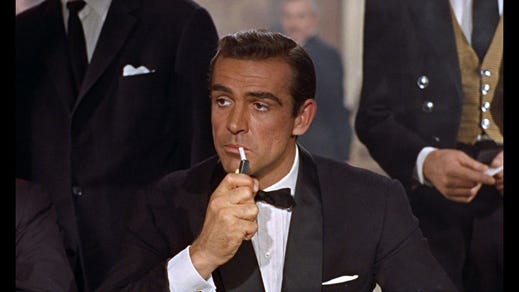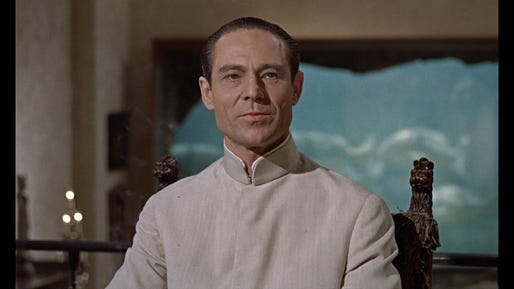You Only Live Twenty-Thrice: "Dr. No"
“You Only Live Twenty-Thrice” is a look back at the James Bond films.
Each Friday until the release of the 23rd official Bond film, “Skyfall,” we will revisit its 22 official predecessors from start to finish, with a bonus post for the unofficial films in which James Bond also appears.
“Bond. James Bond.”
It’s amazing to think this declaration was once just a line of dialogue — a straightforward, snub-nosed introduction to the protagonist of a million-dollar movie from 1962 named “Dr. No.”
It’s also impossible to encapsulate everything those words mean today.
These words became an impetus for 50 years of discourse and debate about cinematic swagger, style, sex, misogyny, politics, music, opulence, commerce and violence. And they firmly cemented the cultural immortality of film’s most enduring character. (No need to muck things up with such a bet-hedging word as “arguably.”)
And it all started five decades ago with “Dr. No."
Many Hollywood studios passed on this adaptation of Ian Fleming’s novel, dubbing it “too British” or “too blatantly sexual.” Sean Connery was far from the producers’ first choice to play Bond. Upon “Dr. No’s” release, Time called Bond “a great big hairy marshmallow.” Time has probably been kinder to “Dr. No” than many people were back in 1962. And yet, like most action films of the 1960s, it has its fair share of moments that, to modern eyes, feel dated, flat and square.
Where punching is now incidental in a Bond film, the fisticuffs of “Dr. No” are practically action centerpieces. When our hero pounds a deadly spider with his shoe, orchestral stingers accompany each deathblow. Director Terence Young’s camera lingers on a car slowly careening down a hillside because, well, you probably just didn’t see such a spectacle much back in 1962.
Before the opening-credits sequences became intentionally overblown orgies of art, sex and flames, there was … a psychedelic game of Connect Four.
And there are, in “Dr. No,” numerous germination points that seeded the spoofery of the Austin Powers series — some of them no less silly as drama than they were as laughs in Mike Myers’ films. (The roller scene from the first Powers film is only slightly more exaggerated than one “Dr. No” character’s inability to avoid a slow-moving tank.)
In other words, “Dr. No” just barely sets the template for a franchise so often defined, for better or worse, by its excesses. Babes, beaches and bad guys are the only barometers in “Dr. No” by which future Bond criteria could be measured — and that goes for Connery’s performance as Bond, often chosen as the audience favorite among the six who’ve held the role.
This is a pre-gadget Bond, armed only with his wits and his Walther, who alternates cunning sleuth tricks with dunderheaded decisions. Bond has rarely seemed more like a detective than he does in “Dr. No,” so it’s no surprise that certain lines of dialogue — “He’s either a bad professor or a poor liar” and “Minnow pretending they’re whales, just like you on this island, Dr. No” — feel transplanted from hard-boiled film noir.
“Dr. No” also has slightly more brutal violence, both portrayed and implied, than you’d expect from 1962 — including Bond leaving a beaten-up henchman’s corpse in the back of his car and wringing a towel around his hands while seducing a woman. In this sense, it creates an intriguing parallel to Daniel Craig’s brusque Bond of today.
What remains most stunning about “Dr. No” is its on-location cinematography. Even on a seemingly modest budget, it beautifully captures shimmering water, intoxicatingly blue skies and looming mountains of Jamaica — so strongly you can practically feel the humid thickness of the air. The scope and sweep of the exotic locales is something the franchise would, of course, continue throughout.
Kingston is the city to which Bond is sent for an investigation into the disappearance of Strangways, a British Intelligence Station Chief. Strangways recently acquired samples of radioactive rock near Crab Key — a mysterious island at which some locals have reported sightings of a dragon.
Crab Key is the domain of the enigmatic Dr. Julius No (Joseph Wiseman) — a Chinese-German scientist whose fascination with radiation cost him his hands, now inarticulate mashers made of bionic metal. As Bond investigates, he learns No intends to sabotage America’s Project Mercury space program with an atomic radio beam.
Bond’s mission begins only after a rather amusing dressing-down from his supervisor, M (Bernard Lee), the head of the British Secret Service. Bond, it seems, is partial to his Beretta, even though it jammed on him and caused an injury. M orders him to surrender this “ladies’ pistol” in exchange for a Walther. Watch how Connery puts a nice point of snotty punctuation in his last push of the pistol across M’s desk.
This scene could just be a funny throwaway, but it takes on subtext in two critical ways.
First, it discards wholesale the pistol Bond wields in the books — a symbolic change that implies Bond would be a new man on the screen independent from the page. Second, Bond’s reluctance to part with a gun that may look more stylish — but lacks the stopping power he needs — suggests he’s relatively new to the spy game, thus aligning Connery’s introductory appearance with Craig’s.
In both “Dr. No” and 2006’s “Casino Royale,” Bond is depicted as an overconfident, fallible secret agent, with impulse and impudence simmering beneath his suave surface that gets him into more trouble than he needs.
In “Dr. No,” it starts with the way Bond handles No’s henchman R.J. Dent, a professor who purposefully misleads Bond and knows more about Strangways than he lets on.
Suspecting that Dent plans to kill him, Bond dummies up the bed at a cabana — where Bond has bedded femme fatale Miss Taro before shuffling her off to the slammer — and lies in waiting for Dent to arrive. In the dark, Dent empties his pistol into pillows, and Bond gets the drop on Dent. When Dent tries to fire his empty pistol at Bond, the agent plugs him — with one in the back for good measure.
It’s a cold-blooded kill for sure, and a controversially violent one for that era of cinema, but it’s one of the dumbest things Bond could do. Dent seems too spineless to swallow the cyanide pill that No’s other henchman chomp down on when captured — the perfect canary to sing about what’s really going on at Crab Key and what awaits Bond. But pumping Dent with lead before pumping him for information is a rookie mistake for which Bond pays once he finally infiltrates No’s hideout.
That’s the setting for Bond’s other major miscue. In an earlier, brilliant scene, Bond rigs his hotel room to detect intrusion. When Bond returns, happy to find his quarters subtly ransacked and his suspicions proven, he thinks twice about drinking from an open bottle of liquor and cracks the seal on another. And yet he never thinks twice about the coffee Dr. No’s servants pour and again, he suffers for it.
“No’s” script doesn’t come close to using this fallibility as an underlying theme in the way “Royale” does. But it’s still a glance into the mindset of a man who’s maybe just a little too confident so early in his spy career.
This subtext also enhances how Connery, then in his early 30s, was feeling out what was not yet an iconic role. This wasn’t Connery’s first prominent film — he had the lead in Disney’s 1959 “Darby O’Gill and the Little People” — but it’s clear that instinct hadn’t yet kicked in for exactly where he would take Bond. Connery still puts across an arresting sense of assuredness with oh-so-faint hints of anxiety.
He also has only the most cursory chemistry with the inaugural Bond girl — Honey Ryder, played by Ursula Andress. That’s mostly the fault of how the story doesn’t introduce Honey until an hour has passed. But oh, the smelling salts required after that entrance — Honey striding forth from the sea, all saltwater and sex.
While Honey is a nubile nymph with an hourglass figure wound to just the right time, she’s also one of two sidekicks in Crab Key who doesn’t pull much weight. The other is Quarrel (John Kitzmiller), an islander introduced as a savvy local with inroads where it counts most. By the time Quarrel meets his untimely end, though (at the fire-spitting end of that “dragon,” which is actually a well-fortified tank), he’s disappointingly childish and overly spooked by his superstitions.
Essentially, Bond goes it alone against Dr. No, introduced in the movie as a disembodied voice that sounds like an omnisciently malevolent John Malkovich. Although undoubtedly evil, No’s mixed-race heritage gives him geopolitical motivation for his sinister deeds; wanted by no one, he’ll target everyone.
In the end, “Dr. No” is much more mystery than action-adventure — comparatively low-key to almost everything that would come after it. But even legends have to start somewhere, and looking back at “Dr. No,” these reminders of how Bond wasn’t always “Bond,” as it were, are fascinating.
Next week: “From Russia with Love”
BULLET POINTS
Anthony Dawson, who portrays ill-fated henchman Professor R.J. Dent, would go on to play SPECTRE mastermind Ernst Stavro Blofeld in “From Russia with Love” and “Thunderball.” His face was not seen in either film
“Dr. No” is one of only two Bond films with a credited female writer. Johanna Harwood would also co-write “From Russia with Love.
The film opened to mixed reviews and was also condemned by both the Vatican and the Kremlin.
Ursula Andress was, quite literally, cast for her body. Both her speaking and singing voices were overdubbed — the former by Nikki van der Zyl. Amazingly enough, van der Zyl is the voice of almost every other woman in the film — save Miss Moneypenny, Miss Taro and a few others — and “re-voiced” women in eight additional Bond films.
Cary Grant, Patrick McGoohan and David Niven (who would later appear in the spoof “Casino Royale”) were all courted to play Bond. Likewise a mid-30s Roger Moore, whom legendary Bond producer Albert “Cubby” Broccoli allegedly dismissed then as “too young, too pretty.”




